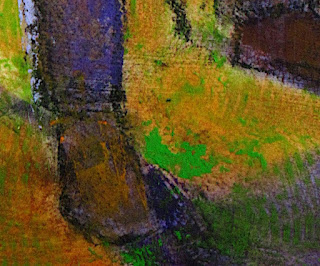 |
| Finished 12x14 pastel/oil/cold wax |
Back in the winter—back before the pandemic—our local art group embarked on a series of life drawing sessions. We managed to get just one under our belts before the world collapsed upon itself. Well, the other day, while looking over my sketches, I realized that a couple had potential. With the hot weather driving me into the studio in the afternoons, I decided to take one and make something of it.
I had in mind that I wanted to try an idea I've had about pastel. Pastel is what I call a “crossover” medium. You can draw with it, or you can paint with it. In drawing, one makes marks with the point or edge of the pastel stick; in painting, one makes marks with the broad side. I especially like the way a pastel painting can have all sorts of scratchy “drawn” marks beneath a more painterly application. The drawing remains, showing some of the artist's process. I wondered if I could find a way to retain the drawing aspect of pastel while combining it with oil paint and cold wax medium. I decided to give it a try.
First, I needed to transfer my sketch to a painting surface. Because I didn't want to damage the original sketch, which was done with soft vine charcoal on newsprint, I photographed it, converted it to grayscale, maximized the contrast, and then printed it out in a size appropriate for my 12x14 panel. (The panel, by the way, I had already prepared with one layer of acrylic gesso, one of Gamblin's PVA size, and then two of Art Spectrum Clear Pastel Primer.) I coated the back of this print with a thin layer of compressed charcoal, placed it “dirty side” down on my panel, and used a pencil to trace the major lines. This transferred a thin charcoal outline to my panel.
Here's the original vine charcoal sketch on newsprint:
Here's the high-contrast, grayscale version:
Next, using a dark pastel, I refined the drawing and darkened lines so I could see them better. After this, I blocked in my major color masses with Pan Pastels. And then the fun began. I needed to fix the pastel so it wouldn't be disturbed by the application of oil paint and cold wax. To do this, I:
1. Heavily sprayed the underpainting with matte fixative, but not so much as to liquefy the pastel and make it run; then
2. Brushed on a coat of Gamblin's Galkyd Lite.
Once the Galkyd Lite was dry, I found it had completely sealed the pastel. I was pleased to see that all my interesting little marks were still quite visible. Here's the painting in this state:
From here, I proceeded to paint on top of all this with Gamblin's cold wax medium and oil paint. Here's the finished painting:
And some detail:
I like the effect of the textured wax and touches of oil paint against the pastel underpainting, but I'm not sure I'll take the painting any further. One could, of course, but the risk is that the drawing will become more and more obscured with paint and wax. But the experiment worked, and I'm sure I'll try this again. Maybe you'll give it a try!







